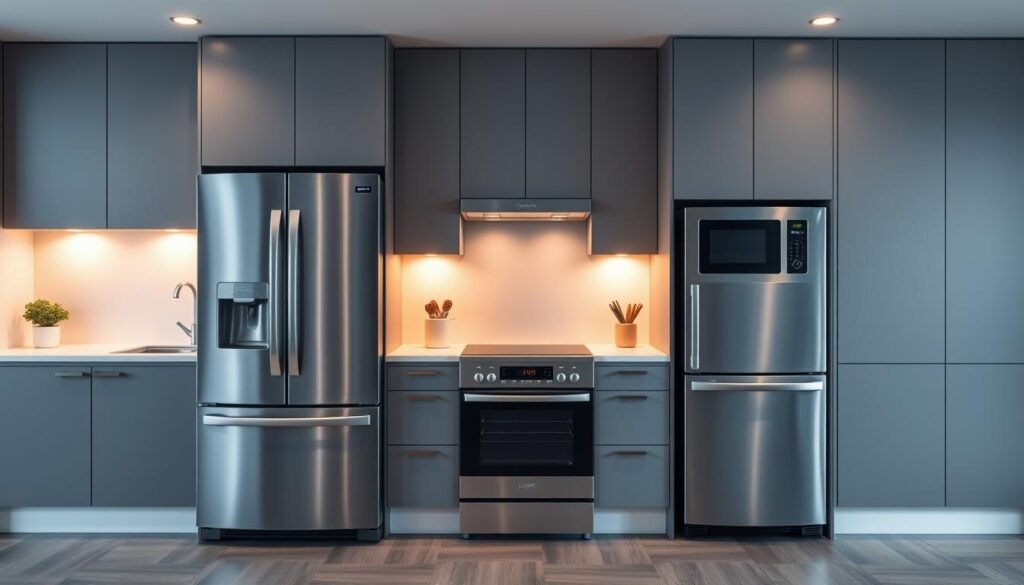Did you know a simple wind turbine can save over £340 a year on electricity bills? As energy prices rise, making your home energy-efficient is key. By using renewable energy and smart practices, you can cut down on bills and help the planet. This article will show you how to turn your home into a green haven.
Key Takeaways
- Integrating renewable energy sources such as solar, wind, and geothermal can significantly reduce energy costs.
- Conducting an energy audit is a critical step to find where your home is wasting energy.
- Energy-efficient homes can increase property value by lowering utility costs.
- Using Energy Star products can greatly impact your energy bill savings.
- Federal and state incentives can make switching to renewable energy easier on your wallet.
- Proper insulation can cut heating and cooling costs by up to 30%.
- Smart home technology enhances energy management, further improving efficiency.
Understanding Energy Efficiency and Renewable Energy
Learning about energy efficiency and renewable energy is key to a greener home. Energy efficiency means using less energy for the same tasks, cutting down on waste. This can save you money on bills. Renewable energy, like solar and wind, is natural and doesn’t harm the planet.
Using both can make your home use less energy and be kinder to the environment.
What is Energy Efficiency?
Energy efficiency is about using less energy for the same tasks. Using energy-saving appliances can cut down on energy use. These appliances often have the Energy Star label, showing they meet high standards.
Choosing these appliances can save you money and help the planet.
Importance of Renewable Energy
Renewable energy is vital for fighting climate change and reducing our use of fossil fuels. Switching to solar, wind, or hydropower cuts down on harmful emissions. In the UK, over 1.3 million homes use solar panels, even on cloudy days.
This helps the environment and can lower your bills.
Benefits of Combining Both
Combining energy efficiency with renewable energy makes your home more sustainable. Making your home more energy-efficient means you can use less renewable energy. This could mean a smaller, cheaper system.
Using green tips, like hybrid systems, can make the most of different weather conditions. This approach is good for the planet and your wallet.
Assessing Your Home’s Current Energy Use
Knowing how much energy your home uses is key to making it more efficient. A home energy audit is a first step in this journey. It shows you how much energy you use and where you can save.
By looking closely, you can find ways to use less energy. This makes your home more eco-friendly and saves you money.
Conducting an Energy Audit
Start by checking your energy bills. They can show you how much energy you use. Then, check how well your home is insulated.
Older homes might not have enough insulation. Look at your attic, basement, and crawlspaces. The right amount of insulation changes with energy prices.
Identifying Energy-Wasting Areas
When you audit your home, find out where energy is wasted. Old appliances and gaps in walls are common problems. Moisture can make insulation less effective and damage your home.
Big differences in insulation can cause a lot of heat loss. If your home scores low on an Energy Performance Certificate, you need to act fast.
Tools for Energy Assessment
There are tools to help you assess your home’s energy use. Smart meters track your energy use over time. They help you spot when you use the most.
Thermographic inspections show how well your insulation works. They can spot problems that aren’t obvious. New technology makes these audits more accurate and helpful.
Solar Energy: A Powerful Option for Homes
Energy costs keep going up, and more homeowners are looking at solar energy. Solar energy systems change how we power our homes. Knowing about the different types, how to install them, and the savings can help make smart choices.
Types of Solar Energy Systems
There are mainly two types of solar energy systems: photovoltaic (PV) panels and solar thermal systems. PV panels turn sunlight into electricity. Solar thermal systems make hot water for our homes. Both are key in using renewable energy and cutting down on traditional power use.
Installing Solar Panels
Putting up solar panels is a big step towards saving energy. In the UK, the cost for a home solar panel system is about £7,000. This depends on the size and the property’s details. A system usually takes up 10 to 20 square meters of roof space and has 6 to 12 panels.
Even if your roof doesn’t face directly south, you can benefit. East or west-facing roofs can get 15-20% less energy than south-facing ones.
Cost and Savings Analysis
It’s important to look at the costs and savings of solar panels. Until January 1, 2033, you can get a 30% tax credit on solar system costs. This can help cover the initial costs. The monthly solar loan payments are often less than the average utility bill.
This leads to big savings over time. Payback periods vary, from 11 years in London to 21 years in Belfast. For those wanting to cut energy bills and boost efficiency, solar panels are a great choice. As technology improves, the benefits of solar panels will grow.
Wind Energy Solutions for Homeowners
Wind energy solutions help homeowners use wind power to make electricity. This reduces the need for energy from the grid. At the core of these solutions are residential wind turbines. They turn wind into power for homes.
It’s key to know how these systems work and how to pick the right turbine. This ensures they work well.
How Residential Wind Turbines Work
Residential wind turbines change wind energy into electricity. The wind spins the blades, which power a generator. This generator makes electricity.
Turbines for homes are usually between 400 watts and 20 kilowatts. A turbine placed high enough can help a lot with your energy needs. If your area has wind speeds of at least 9 miles per hour, a smaller turbine can work well.
Selecting the Right Turbine
Think about your home’s energy use and local wind patterns when choosing a turbine. A turbine of 5–15 kilowatts is usually enough for a home using 877 kilowatt-hours a month. Make sure the turbine fits your area’s wind speed to work well.
A 1.5-kilowatt turbine can power homes needing about 300 kilowatt-hours a month. This is if your area has steady wind.
Local Regulations and Permits
Before you install, check your area’s wind turbine rules. Local laws might control turbine height, placement, and design. Getting the right permits is key to follow these rules.
Homeowners need to know these rules to avoid fines or expensive changes later. Understanding these rules helps smoothly add wind energy to your home.

Utilizing Geothermal Energy
Geothermal energy is a top choice for those wanting to heat and cool their homes sustainably. It uses the earth’s steady temperature to save a lot of energy. Knowing how these systems work is key for anyone thinking about using them.
Basics of Geothermal Systems
Geothermal systems use the earth’s heat to control your home’s temperature. They have pipes buried underground that move fluid to heat or cool your home as needed. This method keeps your home comfy and cuts down on fossil fuel use.
The International Energy Agency says geothermal systems are a big help in moving to renewable heating. They predict these systems will make up 27.3% of heating energy by 2027.
Installation Considerations
Before getting a geothermal system, you need to check if your site is right for it. Closed-loop systems are common in homes because they work well and need little upkeep. Open-loop systems might be better if your area has steady groundwater temperatures all year.
Getting a geothermal system set up needs careful planning. This ensures it works well and saves you money in the long run.
Costs vs. Long-Term Savings
Getting a geothermal system costs a lot upfront. But, you’ll save a lot on your energy bills over time. These systems use 25-50% less electricity than old heating and cooling methods.
For example, Equans’ Aquifer Thermal Energy Storage system saved over 60% on energy in the Netherlands. Comberton Village University saw heating costs drop by up to 80% and cut carbon emissions a lot.
| System Type | Initial Cost (£) | Estimated Annual Savings (£) | Operating Efficiency (%) |
|---|---|---|---|
| Closed-Loop | 15,000 | 1,200 | 25-50 |
| Open-Loop | 20,000 | 1,500 | 25-50 |
| Geothermal District | 30,000 | 3,000 | 30-50 |
The Role of Energy-Efficient Appliances
Adding energy-efficient appliances to your home boosts your energy management. These devices use less energy and water than old ones. Choosing Energy Star products means they meet high energy standards, saving you money in the long run.
Choosing Energy Star Products
Look for the Energy Star label when buying new appliances. It shows the product is very energy efficient. For example, a top-notch fridge can cut your electricity bill by £100 a year.
Appliances have EU energy labels from A+++ to D. This helps you pick the most efficient ones for your needs.
Impact on Your Energy Bill
Energy-efficient appliances can cut down your bills. For instance, modern washing machines and dishwashers use less power and water. An A-rated washing machine can save you about £95 over 11 years compared to a D-rated one.
Switching to an A-rated dishwasher can save you around £25 a year. This shows how smart choices can save you money.
Smart Appliances: A Modern Touch
Smart appliances take energy saving to the next level. They use real-time data to reduce energy waste. For example, induction hobs heat directly, saving a lot of energy.
Adding smart appliances makes your life easier and helps the planet. They fit perfectly with your goal of saving energy.

Insulating Your Home for Maximum Efficiency
Insulation is key to keeping your home energy-efficient. It keeps your home at a comfortable temperature all year. Sadly, about 10 million homes in the UK don’t have enough roof insulation, costing them £900 extra each year.
By choosing energy-efficient insulation, you can avoid these costs. It also makes your home a better place to live.
Benefits of Proper Insulation
Insulation has many benefits. It keeps your home’s temperature stable and lowers humidity, preventing mould. Without insulation, your home can lose a lot of heat, through walls and floors.
Adding 270mm of loft insulation makes your home more comfortable. It also cuts down your energy bills. Plus, insulating your hot water tank can save you money right away.
Common Insulation Materials
There are many insulation materials to choose from. Here are a few:
| Insulation Material | Benefits | Typical Cost |
|---|---|---|
| Fibreglass | Good thermal performance, fire-resistant | £5 – £10 per square metre |
| Cellulose | Made from recycled paper, good airflow control | £8 – £20 per square metre |
| Spray Foam | Excellent for sealing gaps, superior thermal barrier | £30 – £50 per square metre |
| Cavity Wall | Fills spaces in walls, enhances heat retention | £1,000 – £2,700 for semi-detached homes |
DIY vs. Professional Installation
Choosing between DIY insulation and hiring a pro is important. DIY can save money but might not be as effective. Professionals ensure proper installation and may offer warranties.
Think about your skills and the project’s complexity. Also, consider the Great British Insulation Scheme (GBIS) for funding to improve your insulation.
Smart Home Technology for Energy Management
Smart home technology is key to better energy management. It lets you control your home’s energy use, saving you money. With smart thermostats and energy monitors, you can adjust your energy use to fit your life.
Smart Thermostats: A Game Changer
Smart thermostats change how you heat and cool your home. They adjust the temperature for you, saving up to 15% on bills. You can control them from your phone, making your home comfy and saving energy.
Energy Monitoring Systems
Energy monitoring systems show you how much energy your home uses. They give you live data to spot where you can cut energy waste. This helps you save money and use less energy.
Integrating Devices for Efficiency
Linking smart devices makes your home’s energy system work better. Smart lights and plugs can cut energy use by 5-10%. This combo of tech and smart living reduces your carbon footprint and saves energy for the long term.
Leveraging Tax Credits and Incentives
Using tax credits and incentives can greatly reduce the cost of renewable energy. In the UK, many financial benefits are available for those investing in sustainable energy. It’s important to understand these government incentives to save money while going green.
Federal Tax Credits for Renewables
The Energy Efficient Home Improvement Credit is a big opportunity for upgrades. From 2023 to 2032, you can get up to £1,200 a year, with no limit. Costs for windows, doors, insulation, and energy systems qualify for these credits.
Home energy audits are also eligible. This is a great chance to check your property’s efficiency.
The Residential Clean Energy Credit lets you claim 30% of solar system costs against taxes until 2032. This makes solar technology more affordable, encouraging more people to use it.
State Incentives to Consider
Many states in the UK offer their own incentives for renewable energy. For example, 36 states exempt the value added by solar systems from property taxes. About half of the states also exempt sales taxes, making it easier to invest in renewables.
Local programs can also help save money. Some cities offer rebates for solar panel installations. For example, homeowners in Fort Collins, Colorado, can get big rebates for systems with solar battery storage. Knowing what your state offers is key when applying for benefits.
How to Apply for Benefits
To get these tax credits and incentives, you need to apply correctly. You must file Form 5695, Residential Energy Credits, to claim the credits. Keeping good records of expenses and audits is important for a successful application.
Getting help from financial advisors or energy consultants can make things easier. They can guide you through the process of applying for benefits.
Sustainable Practices to Complement Renewables
Adding sustainable practices to your daily life boosts the impact of renewable energy at home. By saving water and cutting down on single-use plastics, you help the planet. You also make your home more energy-efficient and sustainable.
Water Conservation Techniques
Using water-saving methods cuts down on resource use. Try installing low-flow taps and toilets. They use less water but work just as well.
These changes save money on water bills. They also help the environment. Every bit of water saved is a step towards protecting our resources.
Reducing Single-Use Plastics
Less plastic waste is key to a greener life. Use reusable bags, containers, and bottles instead. This reduces landfill waste and promotes a sustainable community.
For more tips on saving energy and money, see this resource. It shows how small actions can make a big difference.




